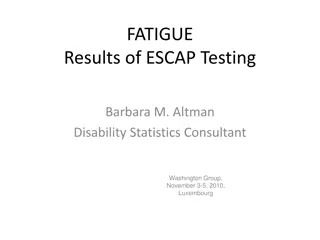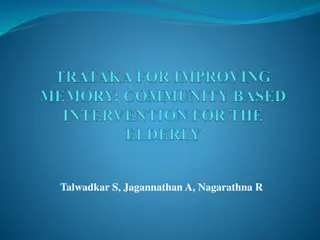Results of Cognitive and Field Tests at 10th Washington Group Meeting Luxembourg
The results of the cognitive and field tests conducted at the 10th Washington Group Meeting in Luxembourg in November 2010 aimed to identify individuals facing vision difficulties, particularly with near or far vision. Various questions were used in the cognitive test to assess vision problems, and detailed analysis revealed challenges in translation across languages. Special focus was placed on identifying people with vision issues not captured by conventional assessments. Samples were purposefully selected from countries like Cambodia, Canada, Kazakhstan, and others.
Download Presentation

Please find below an Image/Link to download the presentation.
The content on the website is provided AS IS for your information and personal use only. It may not be sold, licensed, or shared on other websites without obtaining consent from the author.If you encounter any issues during the download, it is possible that the publisher has removed the file from their server.
You are allowed to download the files provided on this website for personal or commercial use, subject to the condition that they are used lawfully. All files are the property of their respective owners.
The content on the website is provided AS IS for your information and personal use only. It may not be sold, licensed, or shared on other websites without obtaining consent from the author.
E N D
Presentation Transcript
VISION Results of the Cognitive and Field Tests 10thWashington Group Meeting Luxembourg, 3-5 November 2010
Objective of Vision Domain To identify individuals who report difficulties seeing, and to identify within this group those people who have near vision, and far vision difficulty or both
Questions Used in Cognitive Test Question Response Options 1,1 Do you have difficulty seeing, even when wearing glasses 1} no difficulty 2) Some difficulty 3) A lot of difficulty 4) Cannot do at all/ 1) Yes 2) No 1.1a Do you wear glasses to see far away? If Yes read glasses in room question 1) Yes 2) No 1.1b Do you wear glasses to see up close If Yes read glasses in coin question
Questions Used in Cognitive Test Question Response Options 1.1c Do you wear glasses for another reason (other) _____-? 1) Yes 2) No If Yes record other: 1) No difficulty 2) Some difficulty 3) A lot of difficulty 4) Cannot do at all/ unable to do 1.3 Do you have difficulty clearly seeing someone s face across a room (even when wearing your glasses?) If No go to 1.4 _____ age in years 11.1a1 How old were you when the difficulty seeing far away began 12.2i Is your difficulty seeing far away due to a health problem or something else? 1) Due to health problem 2) Something else ___
Questions Used in Cognitive Test Question Response Options 13.1i Does your difficulty seeing far away limit your ability to carry out daily activities? 1) Yes 2) No 13.2b1 Does your difficulty seeing far away limit your ability to carry out other activities that are not part of your day-to-day life> 1) Yes 2) No
Cognitive Test Do you have difficulty seeing even when wearing glasses? No Some A Lot Unable to Skipped, not asked Total Persons Total Persons Percent 72 57 18 6 2 155 46 37 12 4 1 100 Cambodia, Canada, Kazakhstan, Maldives, Mongolia, Philippines, South Africa, Sri Lanka and United States Samples selected purposively
Cognitive Test Detailed analysis of responses revealed confusion by even when wearing glasses clause Difficulties in translating the clause in a consistent way across all languages WG SS set question identified people with difficulties not picked up by either the close or far sight questions Seeing someone s face across a room had a lot of variation
Cognitive Test On seeing the picture on a coin, respondents had variable interpretation from seeing a coin in street to being a coin inspector Activities considered for daily activities included paid employment, housework, looking after children, watching television and sleeping
Cognitive Test Wording change for wearing glasses to see up close i.e., Do you wear glasses for reading to see up close Order of questions questions on glasses use and difficulties for far vision were placed together as well as near vision glasses use and difficulties question; age of onset and limitation in daily activities were asked in general Deletion of question glasses for other reasons, limitation of activities that are not part of day-to day life
Questions Used in Field Test Question Response Options VIS_SS Do you have difficulty seeing, even when wearing glasses? 1} no difficulty 2) Some difficulty 3) A lot of difficulty 4) Cannot do at all/ unable to do 7) Refused 9) don t know 1) Yes 2) No 7) Refused 9) don t know If cannot do at all/unable to do to VIS_SS, skip to VIS_5 VIS_1 Do you wear glasses to see far away? If Yes, include glasses clause in VIS_2
Questions Used in Field Test Question Response Options VIS_2 Do you have difficulty clearly seeing someone s face across a room {even when wearing these glasses?] 1} no difficulty 2) Some difficulty 3) A lot of difficulty 4) Cannot do at all/ unable to do 7) Refused 9) don t know 1) Yes 2) No 7) Refused 9) don t know 1} no difficulty 2) Some difficulty 3) A lot of difficulty 4) Cannot do at all/ unable to do 7) Refused 9) don t know VIS_3 Do you wear glasses for reading or to see up close? VIS_4 Do you have difficulty clearly seeing the picture on a coin [even when wearing these glasses]
Questions Used in Field Test Question Response Options VIS_5 How old were you when the difficulty seeing began ___ age in years 777)Refused 999) don t know 1) Not at all 2) A little 3) A lot 4) Completely 5) Refused 6) Don t know VIS_6 How much does your difficulty seeing limit your ability to carry out daily activities
Results - Do you have difficulty even when wearing glasses (%) No Some A lot TOTAL Persons 18 20 20 20 20 14 155 Cambodia Kazakhstan Maldives Mongolia Philippines Sri Lanka TOTAL 68 63 81 77 83 73 74 27 31 13 19 15 23 21 5 6 6 3 12 3 4 Less than 1% for the following categories for all countries: Unable to Skipped Not asked
Results - Do you have difficulty even when wearing glasses (%) Glasses clause reported as confusing to many respondents Wording being distracting from the main focus of the question Elicited incorrect responses as reported by interviewers
Results Use of glasses for distance and close vision correction (VIS_1 and VIS_3) Do you wear glasses for reading or to see up close (%)? Yes 8 4 No 13 75 Total 21 79 Do you wear glasses to see far away (%) ? Yes No Total 12 87 100 25% of respondents reported wearing glasses either to see up close or far away or reading 12% reported both for reading or to see up close and to see far away wearing glasses
Results - Use of glasses by severity of vision difficulty Do you wear glasses for reading or to see up close (%)? No Glasses 84 50 Glasses 16 50 Total 100 100 Do you have difficulty seeing, even when wearing glasses (%) ? No Some A lot Unable to do 42 100 58 0 100 100 16% of those reporting no difficulty reported wearing glasses 50% with some difficulty reported wearing glasses and this percentage rose to 58% among those with a lot of difficulty.
Results vision difficulty seeing picture on a coin vs. someone s face across the room (n=6309) Do you have difficulty clearly seeing someone s face across a room? No difficulty Some difficulty A Lot Unable to do Do you have difficulty clearly seeing the picture on a coin No difficulty Some difficulty A lot Unable to do 5237 270 22 0 288 308 30 2 24 1 33 4 45 4 0 2 among those with no close vision difficulty , 5% reported some far vision difficulty among those with no far vision difficulty , 6% reported with some close vision difficulty
Results VIS_SS vs. difficulties on far or near vision (n= 6309) Do you have difficulty seeing even when wearing glasses? No difficulty Some difficulty 636 A Lot Cannot do at all 0 Do you have difficulty clearly seeing someone s face across a room OR Do you have difficulty clearly seeing the picture on a coin? 3% (n=148) reported no difficulty seeing but difficulty in far and near vision Much larger (n=636) with no difficulty in far and near vision but some difficulty in VIS_SS No difficulty Some difficulty A lot Cannot do at all 4548 62 142 640 87 0 5 1 55 2 105 10 0 0
Results degree that vision difficulty affects person s ability to do daily activities (any degree of vision difficulty is n =1760) How much does your difficulty seeing limit (in %) Not at all A little A lot Completely Difficulty seeing even when wearing glasses No difficulty 39 53 6 2 Some difficulty A lot Cannot do at all 44 49 6 <1 20 0 38 0 38 25 3 75 as reported seeing difficulty increases, the subsequent impact on the ability to carry out daily activities also increases Of those with some difficulties, only 6% reported having their daily activities limited a lot Rises to 41% for those with a lot of difficulty and 100% for those unable to see
Results degree that vision difficulty affects person s ability to do daily activities (any degree of vision difficulty, n= 1760) How much does your difficulty seeing limit your ability to carry out daily activities? (in %) Not at all A little A lot Completely Overall difficulty seeing (only for those reporting some difficulty in one or more of VIS_SS, VIS_2 or VIS_4) No difficulty Some difficulty A lot Cannot do at all 0 100 ** 0 0 45 50 4 <1 19 3 40 17 39 26 3 52 ** error response, question should not have been asked
Recommendations current set of extended questions working but needs minor changes: 1. Delete glasses clause in Vis_ss and have a prior question on use of glasses so that the effect of the glasses question would be the same for Vis_ss, far and near questions; this can be done for the extended set 2. Guidelines for suitable room sizes and distance from the eyes of the picture on a coin 3. For countries without coins, the reference should still remain but an explanation should be provided on what is to be considered Questions on age of onset and impact of difficulty on daily activities to be developed further for all domains
Proposed Set for Vision Question 1. Do you have difficulty seeing? If yes, include glasses clause in question 2, and if no exclude glasses clause in Question 2. 2. Do you have difficulty seeing (even when wearing glasses)? 3. Do you have difficulty clearly seeing someone s face across a room (even when wearing glasses)? 4. Do you have difficulty clearly seeing a picture on a coin (even when wearing glasses)?























